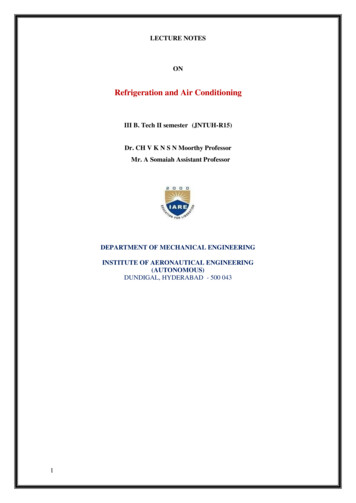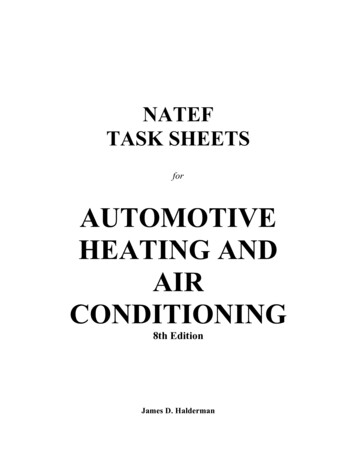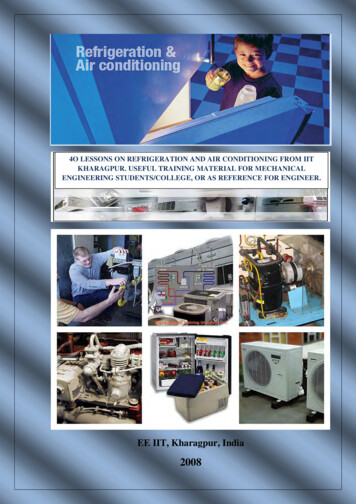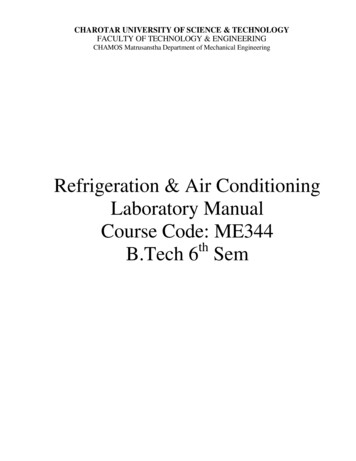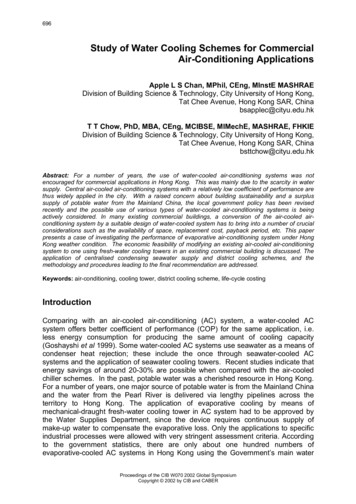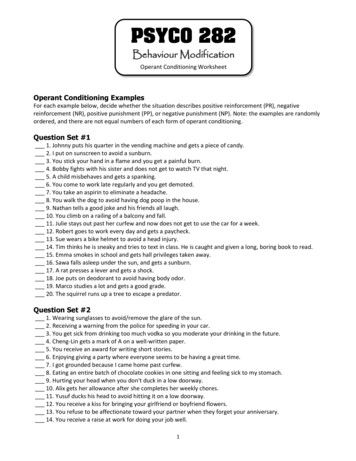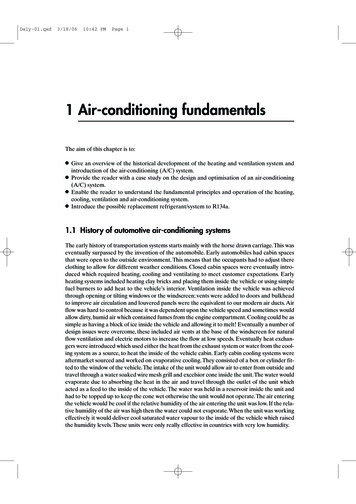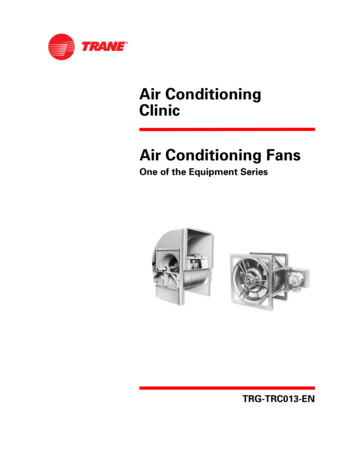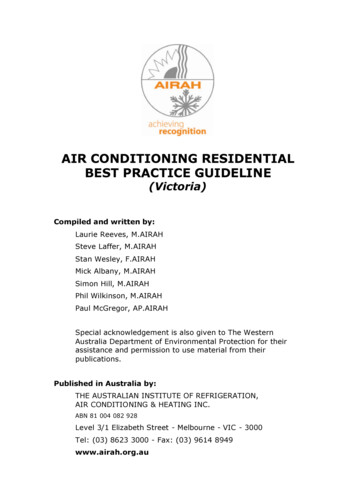
Transcription
AIR CONDITIONING RESIDENTIALBEST PRACTICE GUIDELINE(Victoria)Compiled and written by:Laurie Reeves, M.AIRAHSteve Laffer, M.AIRAHStan Wesley, F.AIRAHMick Albany, M.AIRAHSimon Hill, M.AIRAHPhil Wilkinson, M.AIRAHPaul McGregor, AP.AIRAHSpecial acknowledgement is also given to The WesternAustralia Department of Environmental Protection for theirassistance and permission to use material from theirpublications.Published in Australia by:THE AUSTRALIAN INSTITUTE OF REFRIGERATION,AIR CONDITIONING & HEATING INC.ABN 81 004 082 928Level 3/1 Elizabeth Street - Melbourne - VIC - 3000Tel: (03) 8623 3000 - Fax: (03) 9614 8949www.airah.org.au
Copyright AIRAH 2003This document shall not be copied in part or as a whole withoutprior written permission from AIRAH.DISCLAIMERThe information and advice contained in this document is intendedfor use only by persons who have adequate technical training in thefield appropriate to the contents of this document. This documenthas been compiled as an aid only and the information and adviceshould be verified before any person puts it to any use. The usershould also establish the applicability of the information or advice inrelation to any specific circumstances. While the information oradvice is believed to be correct, the Australian Institute ofRefrigeration, Air Conditioning and Heating Inc. disclaimsresponsibility for any inaccuracies contained within the documentincluding those due to any negligence in the preparation andpublication of the said document.Residential Best Practice Guideline (Victoria) Version 3.22
ContentsForeword . 4Purpose and application. 5Intent . 5Objectives for Suppliers . 6Meeting the objectives of this guideline . 6Compliance . 7Noise Issues. 10What is Noise? . 10How does noise affect us? . 10Sleep di sturbance . 10Annoyance. 11Residential appliance noise. 11Allowable Noise Levels. 11Noise Labelling. 12Education. 13Enforcement . 13Practical steps to minimise air conditioner noise . 14Where will the air conditioner be installed?. 14Make use of barriers for screening . 14Acoustic Barriers. 15Air Conditioning Enclosures. 16Estimating the Noise Impact on Neighbouring Properties. 16Determining a Suitable Sound Power Level. 17Determining Distance to Boundary. 25Load Estimation . 25Legislation, Regulations, Standards and Reference Material . 26Victoria Legislation. 26Commonwealth Legislation. 26Codes. 26Australian Standards . 26AIRAH Reference Material . 27Dispute Resolution. 28Where to get more help. 29Appendix 1 – Acoustic Nomogram . 30Appendix 2 - Data Form . 31Residential Best Practice Guideline (Victoria) Version 3.23
ForewordThe use of residential air conditioning systems in Australian homeshas steadily increased over the last 10 years. Currently there areover 650,000 residential air conditioners sold in Australia annuallyand forward estimates indicate that this figure will continue to rise.The increase in use of residential systems has generated anincrease in complaints about noisy air conditioners.Noise is an integral part of our society today. No-one can escapenoise completely, but if our towns and cities are to remain liveable,it is important to manage the negative impacts of environmentalnoise on people within their homes.As a supplier, installer and maintainer of residential air conditioningsystems, you have a professional obligation to make sure that everypractical and reasonable effort is made not to compromise ourquality of life through noise related issues.AIRAH is pleased to be involved in the development of theseguidelines which are aimed at improving installation practicesthereby minimising and reducing ina ppropriate noise from airconditioning systems.This document represents an important step forward in coordinatingCouncil, community and industry action in managing environmentalnoise. It contains fundamental guidelines to protect both yourselfand your customer from actions that may result in fines and/or legalaction.Follow the basic steps outlined in this booklet and help “design outthe problem”.Jennifer PelvinChief ExecutiveAIRAHResidential Best Practice Guideline (Victoria) Version 3.24
Purpose and applicationThe purpose of this Best Practice Guideline is to define a minimumlevel of service that AIRAH considers should be delivered by a*Supplier in order to provide a quality result for a Customer. AIRAHdoes not monitor or control Suppliers who may use this Guidelineand is not a party to any contract with which it may be used.This Guideline is primarily intended to apply to air conditioning orheating systems for single residential dwellings, including individualapartments in a multi-residence building. It may also be used forindividual small commercial systems, but does not apply to large orcomplicated commercial systems.AIRAH has endeavoured to provide information that is relevant totypical residential air conditioning applications and that is correct atthe time of publication. AIRAH may update this document fromtime to time, and will make updates available. However, it is theresponsibility of the Supplier to ensure that all work is carried out incompliance with all current Legislation and the requirements of allapplicable Standards, Codes and state and local Authorities.IntentThe intent of this Guideline is:To enable all Suppliers to provide refrigerative air conditioning andheating systems that adequately meet the customer's needs and tominimise the risk of any Supplier bringing the industry intodisrepute by: Using equipment that can't deliver its stated capacity.Offering to install equipment without accurately calculating howmuch cooling or heating (duty) is really needed.Installing equipment so that it can't meet the required duty or beproperly maintained.Using unqualified, unskilled, unlicensed and/or inexperiencedtradespersons to specify and install the equipment.To give the Customer confidence that the selection of an airconditioning or heating system will meet their expectations ofsatisfactory operation and price, by: Noting the maximum/minimum ambient conditions at which thesystem will satisfy indoor temperatures.Ensuring alternative choices of equipment or systems are offered.Explaining all aspects of the price: inclusions, exclusions,maintenance work and likely additions.Stating what sort of service is really required and the cost of thisservice, indicating what has been included (and excluded) from anyservice agreement in the contract.*The term suppliers in this document refers to: suppliers, specifiers, installersand those maintaining air conditioning equipmentResidential Best Practice Guideline (Victoria) Version 3.25
Objectives for SuppliersThe objectives of this Guideline are to ensure that the Supplier: Identifies the needs of the Customer. Provides professional advice and a written quotation. Provides a system that meets the identified needs of the Customer. Provides good quality equipment and installation. Provides professional after-sales service.Meeting the objectives of this guidelineThe following items should be adhered to:1.Educate your staff in this Best Practice Guideline.2.Employ qualified trades people and ensure that all installationwork is carried out under the supervision of a person licensed /registered for air conditioning / refrigeration work.3.Tell your prospective customer that your firm designs systemsand then selects, supplies, installs and commissions equipment,all in accordance with the AIRAH Residential Air ConditioningBest Practice Guideline.4.Make sure that you know what your customer's real needs are,in regard to air conditioning and heating. Do they want:5. A low price, or are they prepared to pay for the best possibleair conditioning system? Year-round comfort in all rooms, or just relief from outsideextremes on the hottest or coldest days only? Absolutely minimal noise that won't disturb the lightestsleeper, or a reasonably loud "drone"? A system that makes it visually obvious that the home is airconditioned or one that is almost "invisible"? Minimal running costs, or are running costs not an importantissue? A high efficiency unit defined by a high star rating.Make sure that your customer knows what your proposal willreally achieve. Does the customer: know it will take time to cool-down or heat-up a home duringextreme weather? expect more rooms to be air conditioned than you are offering? know the likely running costs per day? (or over the wholeyear?) really know what noise level to expect from a residential airconditioning system? know what it will look like, indoors and outdoors?Residential Best Practice Guideline (Victoria) Version 3.26
6.Cooling and heating load estimates must only be carried out byexperienced personnel, or under the supervision of experiencedpersonnel, and include appropriate allowances for internalloads, infiltration, fan gains and duct heat gain/loss. TheSupplier shall retain calculations on file for the duration of thewarranty period.7.Design outdoor conditions should be selected from AIRAH DA09,Load Estimation & Psychrometrics 'comfort' criteria for thenearest location, adjusted if necessary for the actual localclimate. Note that design conditions only a few kilometresinland may be quite different from coastal locations.8.Equipment selection must be based on the design indoor andoutdoor conditions, adjusted if necessary to account for theinstalled plant configuration (e.g. heat gain from surroundings,recirculation). Unit capacity must be capable of achieving boththe calculated sensible and total loads.9.Where the building occupant does not plan to operate the plantcontinuously, but will switch it on say, after returning home ona very hot (or very cold) day, an appropriate "cool-down/warmup" allowance must be included in the calculated loads so thesystem has sufficient reserve capacity to reach comfortconditions in a reasonable time.10. Ensure that your staff are familiar with the AustralianStandards, Codes and Legislation applying to the installationand have access to appropriate reference documents. Refer tothe AIRAH Residential Air Conditioning Best Practice Guideline.11. Install systems with adequate space and access to carry outproper maintenance.Where the Customer is unwilling toprovide adequate space or access, explain and confirm inwriting the likely effect in terms of ongoing costs andunsatisfactory or reduced plant life.ComplianceA Supplier shall not advertise use of this Best Practice Guidelineunless it is used and fully complied with on all applicabl e projects(except when specifically excluded by the Customer).Compliance with this Guideline involves completion of allrequirements that are relevant to the project, as initialled on thecopy of this Guideline supplied with the quotation. The Supplier willindicate compliance with the Best Practice Guideline by completingthe Data Form on the last pages of this booklet and leaving it withthe Customer.Residential Best Practice Guideline (Victoria) Version 3.27
The following checklist should be adhered to by the Supplier.BEST PRACTICE CHECKLISTPhaseArrive at the agreed time. If an appointment cannot bekept, advise the Customer in advance and agree analternative time.Inspect the site and discuss the Customer's requirements toidentify their needs.Suggest alternatives if appropriate. If requested, provideindicative pricing for each.Agree the system type to be used.Determine required equipment capacity using anappropriate calculation method.QUOTATIONDetermine Local Council requirements (if any) in relation tothe works.Provide a detailed quotation including: Calculated heating and cooling capacity, statingcalculation method used, indoor and outdoortemperatures for Summer and Winter used forcalculations and expected indoor temperaturetolerances. Description of the system to be provided (equipmentmanufacturer, heating and cooling capacity at statedindoor and outdoor conditions, noise levels, numberand location of outlets, zones, controls and the like). Statement on required/recommended noise levels andthe extent of the Supplier's responsibility. Price and payment schedule. Inclusions and exclusions (Councilapplication/fees/requirements, power supply,supports/plinth, drainage, covers for exposed pipingand wiring, cleanup, rubbish removal and the like).Residential Best Practice Guideline (Victoria) Version 3.28
QUOTATION Warranty (length, conditions and exclusions).Insurance (what is and is not covered by theSupplier's policy).Details of recommended servicing frequency andexclusions. Nominate price of full service for firstyear.A copy of this Best Practice Guideline, with initialsagainst the requirements that will be completed.Declaration by a management representative that thework will be carried out in accordance with this BestPractice Guideline.If an air conditioner is sold using door to door salestechniques, a 10 day cooling off period applies. Otherwise,there is no cooling off period.Under the Trade Practices Act 1974, an implied warrantyapplies to air conditioning supply and installation. Checkwith state authorities for more information.Utilise equipment from established manufacturers capableof providing spare parts and technical backup.INSTALLATIONEnsure installation is performed by, or under thesupervision of qualified, licensed/registered personnel.Ensure equipment, materials and installation is inaccordance with all relevant legislation and AustralianStandards and Best Practice Programs.Commission the equipment with calibrated instruments andan established checklist, using experienced personnel. Acopy of the completed checklist shall be provided to theCustomer.AFTER SALESProvide the Customer with operating instructions and a(brief) schedule of recommended maintenance.For at least two years after installation, remind theCustomer when a routine service is recommended. Servicevisits for the first year shall be at the fixed price nominatedin the quotation.Utilise a service checklist and provide a copy to theCustomer after each service.Promptly attend to any defects identified during thewarranty period.Residential Best Practice Guideline (Victoria) Version 3.29
Noise IssuesWhat is Noise?When environmental noise reaches elevated levelsin our living spaces, it can have significant impactson our health and well being by disturbing sleepand interfering with relaxation and communication.Noise by definition is sound that is unwanted orunpleasant in some way. Due to the range ofnoise that can be heard by the human ear, a scalewas developed called the ‘decibel scale’ (dB(A)), which is used torepresent how loud a particular noise is.How does noise affect us?When noise becomes too loud in our living places, it can havesignificant impact on our health and wellbeing by disturbing andpreventing sleep, relaxation and communication. Noise can alsoaffect our performance, learning and stress levels.The level of annoyance experienced from the noise depends on thelevel of the noise, type of noise, how often it occurs, how long itgoes for, time of day or night and the individual’s own tolerance.Sleep disturbanceSleep is necessary for the basic physical and mental functioning ofhealthy people. Noise can interfere with sleep in a number of ways.It can: prevent people from falling asleep cause awakenings interrupt quality of sleep affect performance and mood the next dayResearch also indicates exposure to night time noises also inducesecondary effects, so-called after effects. These effects that can bemeasured the day after the night-time disturbance and are detectedwhile the individual is awake.The secondary effects includereduced perceived sleep quality, increased fatigue, depressed moodor well-being, and decreased performance.Research has shown that sleep disturbance is complex anddependant on a number of factors, including the level of nuisancenoise compared with the background noise, frequency of the noiseand the percentage of low-range components within the nuisancenoise. This combined with particular individual attributes (such asstress levels, medical conditions and level of hearing) can all lead tosleep disturbance.Residential Best Practice Guideline (Victoria) Version 3.210
AnnoyanceThe term ‘annoyance’ is typically used to sum up the negativeemotions people express to unwanted noise that impacts on theirability to undertake activities such as sleeping, relaxing or reading.These emotions can include anger, dissatisfaction, agitation andhelplessness.Annoyance levels are influenced by: the level of noise type of noise how often it occurs how long it goes for the time of day or night psycho-socialfactorssuchastheindividuals ability to shut out the noise, their emotional statusand disposition to the noiseNoise annoyance can result in changes in behaviour, such as closingwindows, not using balconies and turning up the television volume.In some cases annoyance can be extreme and can lead toaggression.Residential appliance noiseChanging lifestyles and new technologies have seenthe increased use of powered appliances.Airconditioner noise complaints made to city councilshave greatly increased over the past few years andmay be attributed to a number of factors includinga decrease in distance between neighbours due toan increase in high density living, combined with anincrease in domestic air conditioning sales.Allowable Noise LevelsThe Environment Protection (Residential Noise) Regulations 1997include time restrictions for the use of domestic air conditioners.The restricted times are as follows:Monday to Friday:10pm to 7amWeekends and public holidays:10pm to 9amResidential Best Practice Guideline (Victoria) Version 3.211
These prohibited times apply when the noise can be heard frominside a habitable room of another premises. A habitable room isdefined as any room other than a kitchen, storage area, bathroom,laundry, toilet, pantry, garage or garden shed.Further Environment Protection Authority (EPA) information hasindicated that the level of 40dB(A) at night might be an appropriatelevel to use as a guide for calculation purposes.As a guideline, the EPA recommends that during the day, airconditioner noise does not exceed the background noise level bymore than 5dB(A) sound pressure level, as measured at theproperty boundary.Complaints about air conditioner noise are dealt with by localcouncils. If councils receive a complaint from a neighbour, they cancontact the owner of the air conditioner and undertake mediationbetween the owner and neighbours. They can also issue the ownerwith a notice, and if the owners do not comply councils can issuethem with fines.Therefore it is important to select the quietest air conditionerpossible and have it installed as far away from any surroundingdwellings / houses.Noise LabellingResident ial air conditioners should have a label clearly displayedwhich shows the Sound Power Level (Lw) of the unit.The Sound Power Level will give you an indication on how noisy theair conditioner will be outside the customer’s house. The higher thenumber, the louder the airconditioning unit will be.Some air conditioners may also haveSound Pressure Levels (Lp) stated onthe label. This number is different fromthe Sound Power LevelResidential Best Practice Guideline (Victoria) Version 3.212
EducationNoise issues associated with the use of appliances such as airconditioners are often the result of the operators being unawarethat their actions are adversely affecting neighbours. Operators arealso unaware that by exceeding noise levels, they are breaking thelaw and could be fined for such activities.Raising people’s awareness of noise nuisances and potentialpenalties that may apply will ensure reduction of these nuisances.Likewise, limited advice from retailers and installers, and lack offorethought and planning by owners, retailers and installers on thelocation and use of air conditioners also contributes to noise impactsin the community.Manufacturers, installers and retailers have acommunity obligation to provide responsible adviceand service to prevent noise nuisance up-front.Noise labelling for domestic air conditionersprovides consumers with more information in orderto make informed purchasing decisions.EnforcementLocal city councils regulate noise impacts from domestic airconditioners using the EnvironmentalProtection (Residential Noise)Regulations 1997 and section 48A of theEnvironment Protection Act 1970. Theregulations prescribe time restrictions forair conditioning use. Residents can alsomake complaints about excessively noisyair conditioners used during the day.Local councils will alert the owner if acomplaint is made about their airconditioner. Councils can also issuenotices and on-the-spot fines, and havetrained officers who can visit theproperty and check the noise level of theunit.Residential Best Practice Guideline (Victoria) Version 3.213
Practical steps to minimise air conditionernoiseWhere will the air conditioner be installed?Consider where the air conditioner is likely to be installed. Some airconditioning systems are quieter than others and some have moreflexibility in where they can belocated.WrongûAir conditioners should not belocated adjacent to neighbourswindows, bedrooms or livingareas.A/CSplit systems have more flexibility in the way they are installed andthe outside unit can be located closer to the ground. This allowsfences and barriers to be used to screen the noise from the unit.“Discuss noise issues withyour customer before theair conditioner is installed.”Make use of barriers for screeningJust as light reflects from shiny surfaces, noise can be reflectedfrom hard surfaces onto neighbour’s property.Avoid locating the air conditioner near multiple reflective surfacessuch as walls and eaves.Existing barriers such as fences and garden walls can be used toeffectively screen noise from neighbours. It is important to makesure that any barriers used to screen neighbours from noise blocksthe line of sight of the air conditioner and does not contain anyholes or gaps.A/CNoise can reflect fromhard surfaces such aswalls and eavesResidential Best Practice Guideline (Victoria) Version 3.214
A/CTry and avoid multiple reflectivesurfaces when air conditioner isfacing neighboursA solid fence, which completely blocks line-of-sight of the airconditioner and contains no gaps, may help you to reduce your airconditioner noise to acceptable limits.û WrongToo many holesand gapsüRightSolid fencewith no gapsAcoustic BarriersIf the air conditioner is well maintained and operating properly, butis still causing excessive noise, consider the use of acoustic barriers.Fences and garden walls can be used effectively to screenneighbours from noise, however to be effective, any fences or wallsmust block the line of sight of the air conditioner, be of solidconstruction and contain no gaps or holes.If a dividing fence is located between the air conditioner and theneighbour, it may be constructed of standard wooden palings withgaps between the palings. The fitting of additional overlappingpalings could make an existing fence an effective noise barrier.Residential Best Practice Guideline (Victoria) Version 3.215
Add overlapping palingsto close gapsFence withtoo many gapsIf room permits, an air conditioning barriercould be a cost effective option. In order forthis to be effective, the barrier must block lineof sight to the affected neighbours and the airconditioner must be located away frommultiple reflective surfaces, such as cornersand eaves, which could reflect noise anddecrease the effectiveness of the ion to operate. Any barriers must beconstructed in accordance with manufacturerspecifications for ventilation to avoid damageto the outdoor unit.Air Conditioning EnclosuresThere are a number of companies that market full noise enclosuresfor air conditioning units.Also check with the manufacturer of your air conditioner to seewhether they have any after market sales of noise enclosures.“Always make sure when enclosing air conditioning units thatyou check the manufacturers’ specifications for ventilation, toavoid damage to the outdoor unit and voiding of the warranty.”Estimating the Noise Impact on Neighbouring PropertiesThe following pages give simple methods to estimate the likelynoise impact of an air conditioner installation on neighbouringproperties. If you want to determine the suitable “Sound PowerLevel” for a given installation then follow the steps for –Determining a Suitable Sound Power Level.If you have already selected a unit and know the “Sound PowerLevel” and want to know how close to a neighbouring property orfence it can be located, follow the steps for - Determining Distanceto Boundary.Residential Best Practice Guideline (Victoria) Version 3.216
Determining a Suitable Sound Power LevelFollow Steps 1- 4 carefully and it will guide you to decide which airconditioner is suitable by considering the distance between theintended site and property boundary, as well as noise barriers suchas fences.Step 1Distance FactorThe closer the air conditioner is to the neighbour thequieter it will need to be. Follow the steps below andput your answer in Box 1.a) Measure the shortest distance, in metres, between where youwant to put the air conditioner and the property boundary.Mark the distance with an X in Column 1 - AcousticNomogram.b) Bear in mind that to reduce noise, air conditioners are bestplaced in a locationAcoustic Nomogramthat provides theColumn 1Column 2Column 3greatest distanceShortestAmountofPut thisbetween the airdistancenoisenumber inconditioner andtoallowedBox 1.neighbours. Thisneighbour(dBA)could, for example,mean mounting theair conditionerfacing the backfence or front street(check townplanning constraintsfirst).c) As a guideline, theassigned level willbe no more than5dB(A)soundpressure levelabove background*Sound Pressure Levelnoise. For example,if the backgroundNot to Scalenoise level isTo use Acoustic Nomogram see Appendix 1.measured asAdditional copies may be downloaded fromwww.airah.org.au35dB(A) soundpressure level, themaximum allowable noise level for the air conditioner wouldResidential Best Practice Guideline (Victoria) Version 3.217
be 40dB(A) sound pressure level. Assigned noise levels arecalculated at the boundary fence of the property receivingnoise. Measurements are not made at the property emittingthe noise. Before relying on an assigned level for thiscalculation you will need to consider tonality and impulsivenoise.d) Tonality can be simply described as a characteristic whine ordrone. Experience has shown that many air conditioners aretonal when assessed under regulations. If the tone cannot bereasonably and practicably removed from the noise, theinstaller will need to compensate for this in the calculation.This can be achieved by subtracting 5dB from the assignedlevel, prior to doing any calculations.e) If the highest allowable level is 40dB(A) sound pressure level,and you believe a unit is tonal and you cannot reasonably orpracticably remove the tones, you will need to considerlowering the assigned allowable level to 35dB(A) soundpressure level.f) Impulsive means noise containing one or more audible peaksof a short duration. This could be due to the air conditionerstopping and starting or making repetitive noises.g) If the highest allowable level is 40dB(A) sound pressure leveland you believe the unit emits impulsive noise, you will needto lower the assigned allowable level to 38dB(A) soundpressure level.h) Once you have considered whether an adjustment for tonalityis required, mark the amount of noise allowed in the area withan X in Column 2 - Acoustic Nomogram.i) Draw a straight line from the X in Column 1 through the X inColumn 2 to cut through Column 3 - Acoustic Nomogram.j) Read the number from Column 3 - Acoustic Nomogram, wherethe line you have just drawn crosses, and write this in Box 1.Distance FactorBOX 1 Residential Best Practice Guideline (Victoria) Version 3.2 18
Step 2Barrier FactorIf there is a fence or wall between the neighbouringproperties the noise may be reduced. Check thisbelow and
The use of residential air conditioning systems in Australian homes has steadily increased over the last 10 years. Currently there are over 650,000 residential air conditioners sold in Australia annually and forward estimates indicate that this figure will continue to rise. The increase in use of residential systems has generated an

